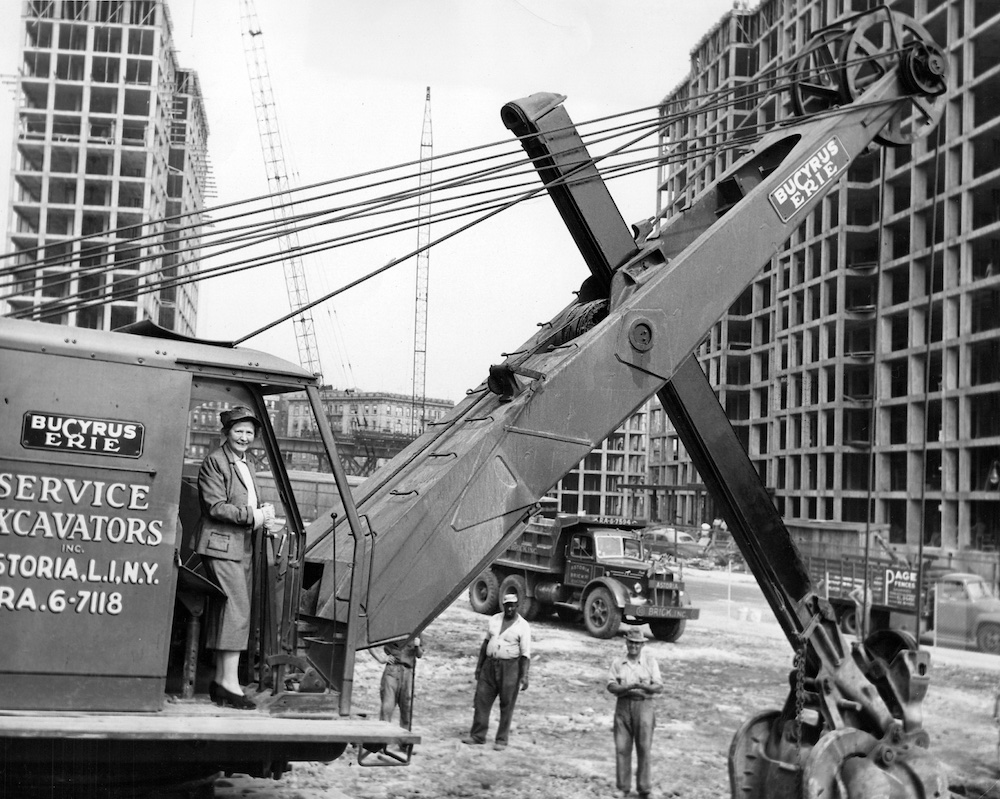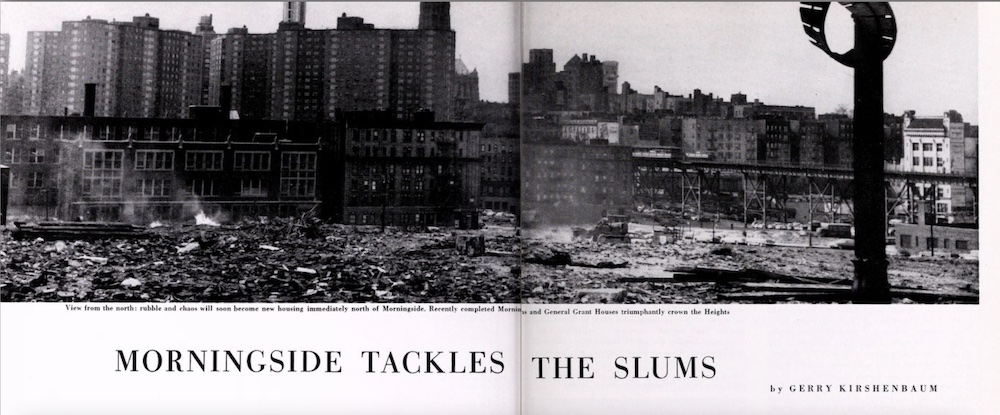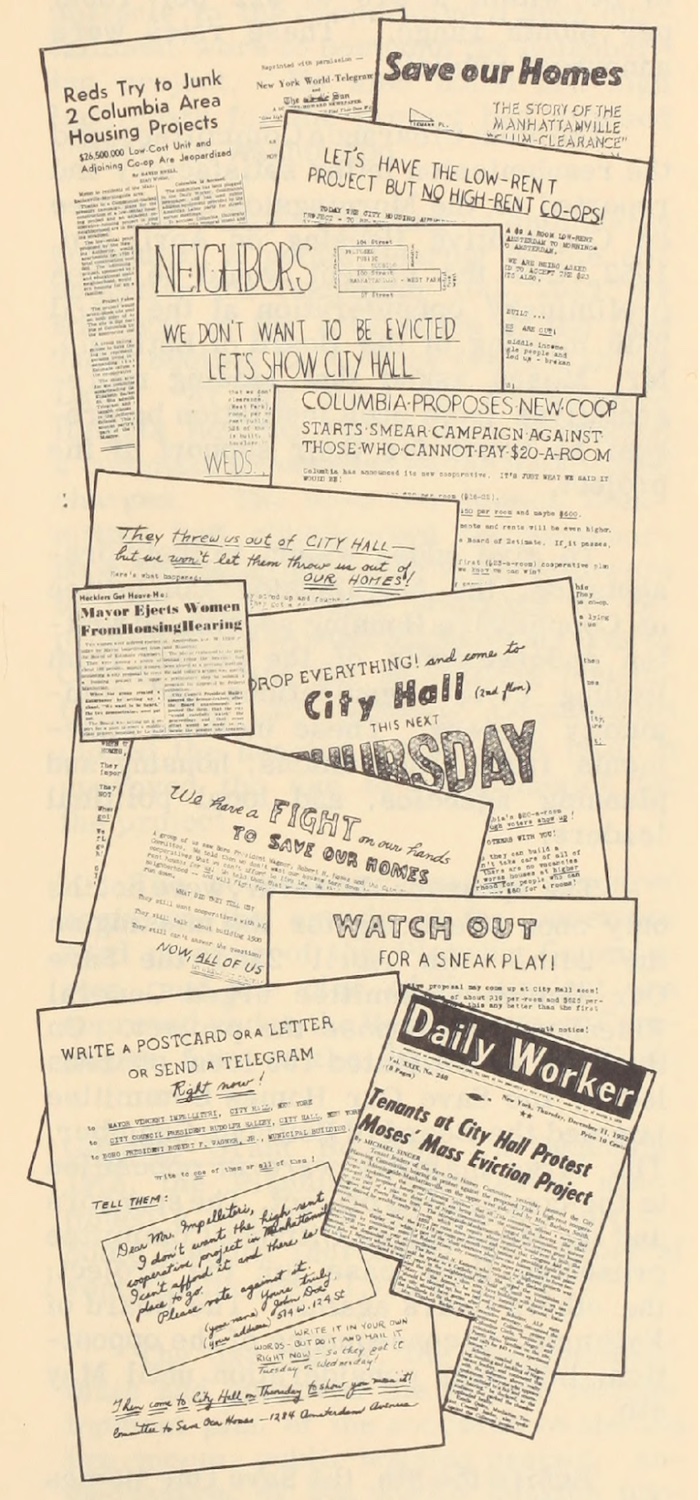 Barnard President (and chairman of the board of the Morningside Heights Housing Corporation, Morningside Heights, Inc.) Millicent Carey McIntosh operates an excavator at the construction site of Morningside Gardens, 1955 (Barnard Archives and Special Collections)
Barnard President (and chairman of the board of the Morningside Heights Housing Corporation, Morningside Heights, Inc.) Millicent Carey McIntosh operates an excavator at the construction site of Morningside Gardens, 1955 (Barnard Archives and Special Collections)
Since relocating from midtown Manhattan to the current locations in Morningside Heights in 1897, Barnard and Columbia administrations have sought to obtain real estate. In a study completed in 2018, the Trustees of Columbia University were identified as the second largest private landowner in New York City by number of buildings and parcels owned and the seventh largest private landowner by square footage. While Barnard owns nowhere near the volume or number of properties that Columbia does, the two institutions have used similar and sometimes coordinated tactics to marshall both the funding and the political will required for property acquisition and tenant eviction: declarations of blight and crime in Black and brown neighborhoods, slum clearance and urban renewal funding, and in the case of Columbia, eminent domain and the assertion of the private university as a public good.
 Barnard Alumnae Magazine, February 1958
Barnard Alumnae Magazine, February 1958
The creation of a segregated, white neighborhood, with middle-class single-family rather than Single Room Occupancy (SRO) housing surrounding the University and other anchor institutions of the “Academic Acropolis,” has been a stated or implicit goal of campus expansion since at least the 1930s. In 1946, past Columbia President Nicholas Murray Butler wrote to the Columbia Board of Trustees urging them to purchase property surrounding the University for future expansion and to protect Morningside Heights from the “greatly feared invasion from Harlem which has been threatened more than once.”
 Flyers of Save Our Homes organizers and clippings from Daily Worker articles, reproduced in Hepner, Elizabeth R, and Morningside Heights, Inc. Morningside-Manhattanville Rebuilds–: a Chronological Account of Redevelopment In the Morningside-Manhattanville Area, With Special Reference to the Development of Morningside Gardens. New York: Morningside Heights, Inc., 1955.
Flyers of Save Our Homes organizers and clippings from Daily Worker articles, reproduced in Hepner, Elizabeth R, and Morningside Heights, Inc. Morningside-Manhattanville Rebuilds–: a Chronological Account of Redevelopment In the Morningside-Manhattanville Area, With Special Reference to the Development of Morningside Gardens. New York: Morningside Heights, Inc., 1955.
Campus expansion has often been met with opposition, legal challenges, and refusal by tenants, community organizations, building owners, students, and at times coalitions of these actors. Examples include: the Save Our Homes Committee, which unsuccessfully resisted the demolition of the racially integrated neighborhood known as the “LaSalle Street Slum,” to make way for the middle-income Morningside Gardens co-op (and later the Grant Houses public housing project); the tenants of the Blennerhasset (507 West 111th Street) who successfully held out against eviction and intimidation orchestrated by area institutions hoping to demolish eight apartment buildings to build an assisted living facility; Black students and community leaders who successfully protested the construction of a University gym on public park land in 1968; and the lawsuits filed by business owners in Manhattanville to protest the declaration of their properties (which they would not sell to Columbia) as blighted in Columbia’s aggressive use of eminent domain.
“Columbia University was certainly a protagonist in this narrative, for a long time – they were responsible for displacement of people throughout the neighborhood. They set out to “clean up” the Upper West Side. It was about Columbia’s expansion, not so much as a university, but as a real estate empire.”
– Nellie Hester Bailey, resident of the Blennerhasset_
Sources
- “The 1904 Blennerhasset Apartments - 507-511 West 111th Street” by Tom Miller.
- “All Property In Superblock Now Acquired” by Stanford S. Sesser and Donald H. Shapiro.
- “The Ascension of Universities as Anchor Institutions and the Threat of Gentrification: Evaluating Columbia University’s Manhattanville Project” by Brianna Sturkey.
- “BREAKING: KC Tenants has blockaded the court entrance. 6 people have chained the doors. The people have closed court for today. Every eviction is an act of violence. #endevictions https://t.co/lkyn0vXosL” by KC Tenants.
- “A Brief History of Anti-Black Violence and Policing at Columbia University” by Columbia University Black Student’s Organization’s Political Committee (Rosalyn Huff, Donovan Redd, Colby King, Katelyn Mitchell, Corrine Civil, Peg Nonez, Aryn Davis, Briana Wood, Payton Johnson, Sabina Thomas, Charlene Adhiambo).
- “Celebrating 50 Years of El Comité-MINP” by Néstor David Pastor.
- “Christiane C. Collins Collection of the West Harlem Coalition for Morningside Park and Urban Problems of the Contiguous Communities: West Harlem, Manhattan Valley, Morningside Heights and Manhattanville: Finding Aid” by Christiane C. Collins.
- “Coalition Against Gentrification: Raising consciousness about Columbia’s impact on the surrounding community” by Columbia Student Coalition Against Gentrification (CAGe).
- “Collection of the West Harlem Coalition for Morningside Park and Urban Problems of the Contiguous Communities” by Christiane C. Collins.
- “Columbia’s Future - The Challenge of Expansion” by William D. Schwartz.
- “Conflict of Interests, Law Enforcement, and Social Change: A Case Study of Squatters on Morningside Heights.” by Mary Anne Brotherton.
- “Death of a Neighborhood” by Richard M. Elman.
- “Federal- and State-Funded Urban Renewal at the University of Pennsylvania” by John L. Puckett.
- “Fighting the War against Blight: Columbia University, Morningside Heights, Inc., and Counterinsurgent Urban Renewal” by M. Carriere.
- “In the Shadow of the Ivory Tower: How Universities Are Plundering Our Cities” by Davarian L. Baldwin.
- “Manhattan Projects: The Rise and Fall of Urban Renewal in Cold War New York” by Samuel Zipp.
- “Marie Runyon Papers” by Marie Runyon.
- “Morningside Area Alliance Records” by Morningside Heights Incorporated.
- “Morningside-Manhattanville rebuilds: a chronological account of redevelopment in the Morningside-Manhattanville area, with special reference to the development of Morningside Gardens” by Elizabeth R. Hepner.
- “New York’s 10 Biggest Property Owners ” by Tanay Warerkar.
- “The Radiant University: Space, Urban Redevelopment, and the Public Good” by Steven Gregory.
- “Rooming at Barnard” by Maya Garfinkel.
- “Saving the Blennerhasset: An Oral History of 507 West 111th Street in Morningside Heights” by Demi McGuire, Wendell Dorris, George Gabriel, and Tom Phillips.
- “Saving the Blennerhasset Oral History Collection” by Nellie Bailey; Don Colflesh; Wendell Dorris; George Gabriel; Demi McGuire and Deland Rivera
- “Spatial Regulation in New York City: From Urban Renewal to Zero Tolerance” by Themis Chronopoulos.
- “Student Coalition on Expansion and Gentrification Blog” by the Student Coalition on Expansion and Gentrification.
- “When Universities Swallow Cities” by Davarian L. Baldwin.
- “Who are the Biggest Landowners in New York City?” by Aleksey Bilogur.
- “Women Picket Harlem Stores” by the New York Times.